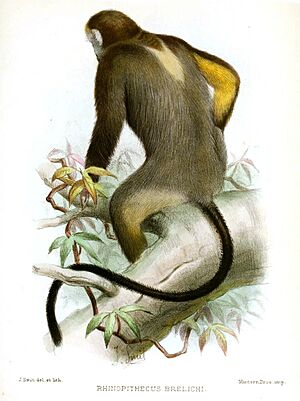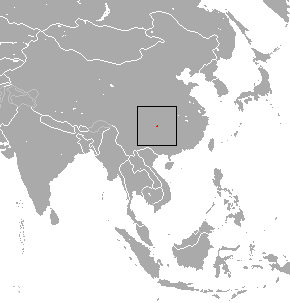Gray snub-nosed monkey facts for kids
Quick facts for kids Gray snub-nosed monkey |
|
|---|---|
 |
|
| Conservation status | |
| Scientific classification | |
| Genus: |
Rhinopithecus
|
| Species: |
brelichi
|
 |
|
| Gray snub-nosed monkey range | |
| Synonyms | |
|
Pygathrix brelichi Thomas, 1903 |
|
The gray snub-nosed monkey (Rhinopithecus brelichi) is a very special type of primate (like monkeys and apes). It's also known as Brelich's snub-nosed monkey or the Guizhou golden monkey. This amazing animal lives only in China.
Sadly, the gray snub-nosed monkey is in great danger. It is one of the most threatened types of snub-nosed monkeys in China. There are thought to be fewer than 400 of these monkeys left in the world. Their biggest threat is losing their home, which is called habitat loss.
Contents
What Does the Gray Snub-Nosed Monkey Look Like?
Adult gray snub-nosed monkeys have long, soft fur. Their fur is usually brown on their upper body and gray on their lower body. They have a white patch between their shoulders. Their head, neck, and the ends of their arms and legs are black. They also have a cool golden stripe above their eyes.
Their chest is golden, and they have chestnut-colored fur on the inside of their knees and upper arms. Their face has no fur and is bluish-white. It's pink around their eyes and mouth. They have a flat nose, which makes them look "snub-nosed." Young monkeys are gray, and their patterns change as they grow up.
Boy monkeys (males) have brighter colors than girl monkeys (females). Adult males usually weigh about 14.5 kilograms (about 32 pounds). Adult females are smaller, weighing around 8 kilograms (about 17.6 pounds). Their body length, not counting their tail, is about 64–73 centimeters (25–29 inches). Their tail is quite long, from 70–97 centimeters (27–38 inches).
Where Do Gray Snub-Nosed Monkeys Live?
The gray snub-nosed monkey lives in a very specific place. They are found only in the Fanjingshan National Nature Reserve in the Wuling Mountains. This area is in the Guizhou province of China.
There are some reports that a few monkeys have moved to a nearby forest. However, scientists have not fully confirmed this yet.
What Is Their Home Like?
These monkeys live in mixed forests. These forests have both trees that lose their leaves (deciduous) and trees that stay green all year (evergreen). They do not live in pine forests.
Their forest home has different kinds of trees, like Asian oak, beech, cherry, maple, and birch trees. They usually live high up in the mountains, at elevations of 1,400–2,300 meters (about 4,600–7,500 feet). When there's a lot of snow, they might move down to lower areas, around 570 meters (about 1,870 feet).
The area where they live gets a lot of rain, especially above 1,600 meters. It often snows in winter, and temperatures can be below freezing for about five months of the year.
How Do Gray Snub-Nosed Monkeys Behave?
Gray snub-nosed monkeys are active during the day. They spend most of their time in trees, but they also walk on the ground sometimes. They move around by walking on all fours, climbing, leaping, and swinging through trees.
What Do They Eat?
Their diet changes with the seasons because different foods are available at different times of the year. They eat many things, including:
- Young leaves
- Leaf and flower buds
- Tree bark
- Fruits
- Seeds (from trees like cherry and rowan)
- Insect larvae (baby insects)
For example, in the first three months of the year, leaves might be only 7% of their diet. But in the next three months, leaves can make up 93% of what they eat! Fruits and seeds can be a big part of their diet from July to September.
How Do They Live Together?
Gray snub-nosed monkeys have a very interesting social life. They live in small groups, but these small groups often join together to form much larger groups called "troops." These troops can have up to 400 or more monkeys! They travel, eat, and sleep together.
A typical small group has about 5–10 members. This usually includes one main male monkey, several female monkeys, and their young. There are also groups made up only of male monkeys, called "bachelor groups." These groups have two to five adult or almost-adult males. They usually stay near the edges of the larger troop. The big troops sometimes split into smaller groups depending on the season.
Why Are Gray Snub-Nosed Monkeys Endangered?
Even though the gray snub-nosed monkey is protected by law, it is still in serious danger. The main reasons are:
- Habitat loss: Forests are being cut down, which means the monkeys lose their homes.
- Illegal mining: Mining activities also destroy their habitat.
- Hunting: Sometimes, people hunt them, even though it's against the law.
- Trapping: They can accidentally get caught in traps meant for other animals.
In 2008, scientists counted about 750 individuals. However, a study in 2020 estimated that there might be as few as 125 to 336 monkeys left.
To help protect them, the Fanjingshan National Nature Reserve was created in 1978. This reserve covers the entire area where the gray snub-nosed monkey lives. Later, in 1986, this area became a UNESCO Biosphere Reserve. In 2018, Fanjingshan was named a World Heritage Site, which gives it even more protection.
See also


